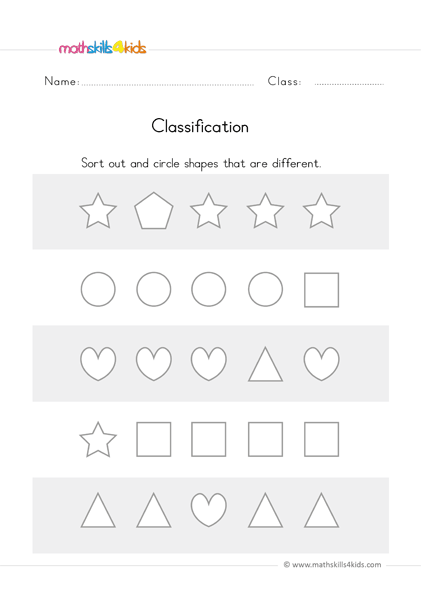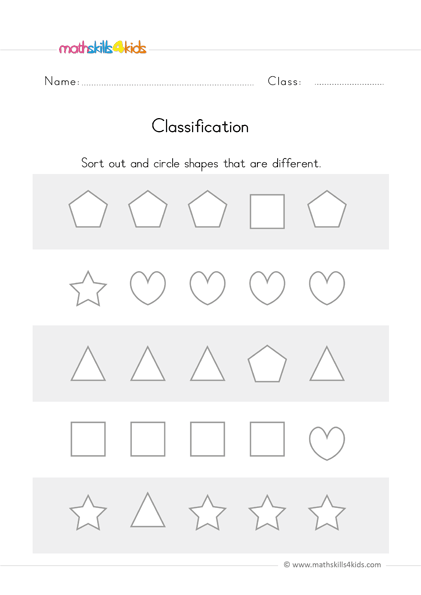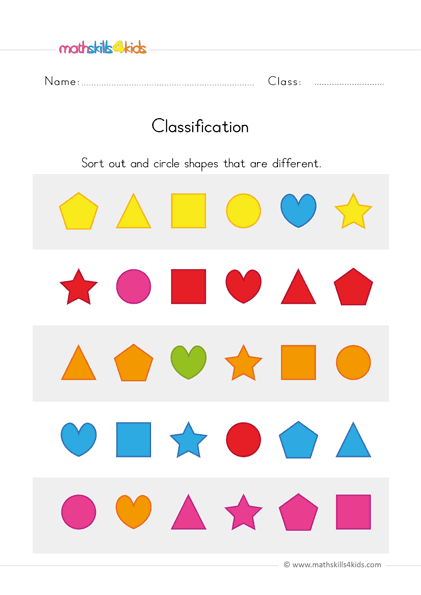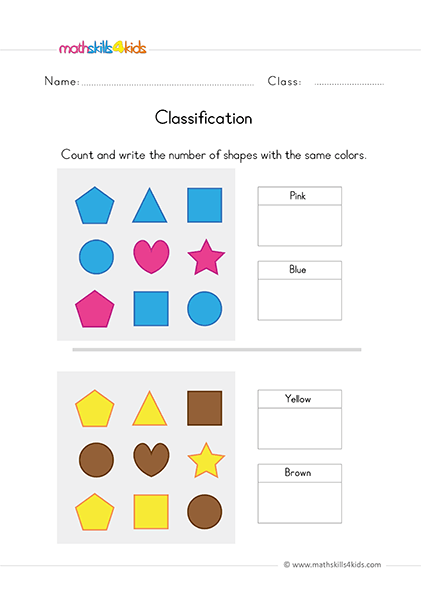Sorting worksheets in pdf: a skill-building activity for preschoolers
Have you ever wondered why your kids keep sorting particular objects from among many? It may, however, seem natural, but it is their first step to skill-building activities in math.
We, therefore, saw that one of the best ways to teach sorting to preschoolers is by using printable sorting worksheets in pdf that they can manipulate and explore. These worksheets are designed to give preschoolers various opportunities to practice sorting by different attributes, such as color, shape, and size. They will also introduce preschoolers to categorizing and recognizing patterns essential for developing algebraic thinking.
-
Sorting is a skill-building activity that preschoolers need to build on and prepare for more advanced mathematical concepts like matching, comparing, etc. However, with various themes and activities to choose from, your little one will be well on their way to school readiness in no time.
The benefits of sorting worksheets for preschoolers
Sorting worksheets for preschoolers can teach various sorting concepts, such as color, shape, size, category, and pattern.
- You can sort different kinds of objects, such as buttons, beads, blocks, stickers, or pictures.
- You can also use different containers to sort into, such as cups, bowls, trays, or boxes. Sorting worksheets for preschoolers can be adapted to different levels of difficulty and interest.
Sorting worksheets for preschoolers is a great way to make math fun and meaningful for your child.
-
BROWSE THE WEBSITE
-
DOWNLOAD FREE WORKSHEETS
-
-
-
What is sorting, and why is it important for preschoolers?
Sorting is the process of organizing objects or information into categories based on their similarities or differences.
For preschoolers, sorting is an important skill to develop as it helps them understand basic concepts like colors, shapes, and sizes. It also helps them develop their cognitive abilities, such as problem-solving and critical thinking.
Preschoolers can improve their ability to recognize patterns, make connections, and understand the world around them by practicing sorting.
In this article, we will show you how to use the sorting worksheets in PDF effectively to help your preschoolers master this vital skill. We will also share some fun activities that you can do with your children to reinforce their sorting skills and make learning more enjoyable.
-
How to use the sorting worksheets effectively
To use the sorting worksheets effectively with your preschoolers, start by introducing the idea of grouping objects based on their similarities or differences, such as sorting toys by color or shape.
Then, please provide them with the sorting worksheets and encourage them to complete the activities independently. You can also mix up the attributes and challenge them to sort by more than one criterion at a time. For instance, you can ask them to sort the cards by color and shape simultaneously.
As they work, ask them questions about the objects they are sorting and help them make connections between the categories. Finally, praise their efforts and celebrate their successes to build confidence and motivation.
Interestingly, the sorting worksheets in PDF are easy to use and require minimal preparation. You only need a printer, scissors, and some glue or tape. You can print out as many copies as needed and cut out the individual cards or objects your children will sort. You can also laminate them for durability and reuse.
-
Sorting by color, shape, and size
Sorting by color, shape, and size is one of the simplest and most common ways to teach sorting to preschoolers. These attributes are easy to recognize and compare, and they help children to develop their visual discrimination skills.
The sorting worksheets in PDF include various sets of cards or objects that feature different colors, shapes, and sizes. You can use these sets to help your children practice sorting by these attributes individually or in combination.
For example:
- Provide a set of colored balls and ask your kids to sort and group the balls by their color (red, yellow, blue, green). Next, ask them to count how many balls are in each group.
- You can also ask them to name the colors aloud as they sort.
- You can also use the set of colored shapes to help your children sort by shape. You can ask them to group the shapes by their shape (circle, square, triangle, rectangle) and then count how many shapes are in each group. You can also ask them to name the shapes aloud as they sort.
- You can also use the set of colored animals to help your children sort by size. You can ask them to group the animals by size (small, medium, large) and then count how many animals are in each group.
- You can also ask them to compare the sizes of different animals using words like bigger, smaller, and same size.
In another exciting way, you can mix up these sets and challenge your preschoolers to sort by more than one attribute at a time. For example, you can use the set of colored shapes and animals together and ask your children to sort by color and shape or by color and size.
-
Using sorting worksheets to introduce patterns and sequencing
You can also use the sorting worksheets to introduce your kids to patterns and sequencing. A pattern is a repeated sequence of objects or events that follows a rule or logic. For example, a pattern can be red-blue-red-blue or circle-triangle-circle-triangle.
Sequencing is arranging objects or events in a logical order or progression. For example, sequencing can be small-medium-large or first-second-third.
Patterns and sequences are essential for preschoolers because they help them to develop their logical thinking skills. They also help them understand the order concept and predict what comes next.
For quick mastery, start practicing with simple patterns, such as ABAB or AABB, and encourage your kids to continue the pattern on their own. As they become more confident, you can introduce more complex patterns and sequences, such as ABCABC or ABBCABBC. With practice, your child will be able to recognize and create patterns independently.
In addition, you can ask your children to identify the rule or logic behind a given pattern or sequence and then complete it by adding the missing cards or objects. You can also ask them to create their own patterns or sequences using the cards or objects provided.
Above all, the idea of introducing patterns and sequences helps preschoolers to develop their problem-solving skills. It also helps them to learn the names of numbers and letters. Patterns and sequences can also be fun to introduce vocabulary and concepts such as first/last, before/after, next/previous, etc.
Fun activities to reinforce sorting skills
Sorting worksheets in PDF format is just one way to teach sorting to preschoolers. There are many other fun activities that you can do with your child to reinforce sorting skills. Here are some examples:
- Sorting toys: You can ask your child to sort their toys by color, shape, size, type, etc. You can also make it more challenging by asking them to sort by two or more criteria simultaneously.
- Sorting laundry: You can ask your child to help you sort the laundry by color, type of clothing, size, etc. You can also make it fun by playing games like matching socks or finding pairs.
- Sorting food: You can ask your child to sort food items by color, shape, size, type, etc. You can also make it more educational by asking them to sort by healthy/unhealthy or sweet/sour.
- Sorting books: You can ask your child to sort books by color, shape, size, type (fiction/non-fiction), genre (fantasy/science fiction), etc. You can also make it more interesting by asking them to sort by their favorite characters or stories.
Sorting is a fun and easy way to teach preschoolers essential skills such as classification, organization, and logic.
Sorting worksheets in PDF format is an excellent tool for enhancing preschoolers' fine motor skills. They are convenient, printable, and customizable. They can also introduce other concepts like patterns, sequences, and sets.
Happy teaching!
-
Thank you for sharing the links of MathSkills4Kids.com with your loved ones. Your choice is greatly appreciated.





